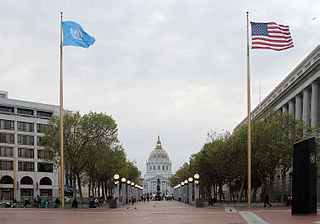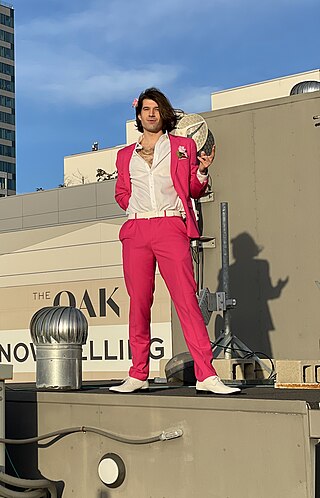
South of Market (SoMa) is a neighborhood in San Francisco, California, situated just south of Market Street. It contains several sub-neighborhoods including South Beach, Yerba Buena, and Rincon Hill.

The Palace of Fine Arts is a monumental structure located in the Marina District of San Francisco, California, originally built for the 1915 Panama–Pacific International Exposition to exhibit works of art. It was constructed from concrete and steel, and the building was claimed to be fireproof. According to a metal plate at the rotunda, it was rebuilt under B.F. Modglin, local manager of MacDonald & Kahn, between 1964 and 1967. In the years 1973 and 1974, the columniated pylons were added. It is the only structure from the exposition that survives on site.

The Civic Center in San Francisco, California, is an area located a few blocks north of the intersection of Market Street and Van Ness Avenue that contains many of the city's largest government and cultural institutions. It has two large plazas and a number of buildings in classical architectural style. The Bill Graham Civic Auditorium, the United Nations Charter was signed in the Veterans Building's Herbst Theatre in 1945, leading to the creation of the United Nations. It is also where the 1951 Treaty of San Francisco was signed. The San Francisco Civic Center was designated a National Historic Landmark in 1987 and listed in the National Register of Historic Places on October 10, 1978.
The Mission District, commonly known as the Mission, is a neighborhood in San Francisco, California. One of the oldest neighborhoods in San Francisco, the Mission District's name is derived from Mission San Francisco de Asís, built in 1776 by the Spanish. The Mission is historically one of the most notable centers of the city's Chicano/Mexican-American community.

The Cartoon Art Museum (CAM) is a California art museum that specializes in the art of comics and cartoons. It is the only museum in the Western United States dedicated to the preservation and exhibition of all forms of cartoon art. The permanent collection features some 7,000 pieces as of 2015, including original animation cels, comic book pages and sculptures.

Rigo 23 is a Portuguese-born American muralist, painter, and political artist. He is known in the San Francisco community for having painted a number of large, graphic "sign" murals including: One Tree next to the U.S. Route 101 on-ramp at 10th and Bryant Street, Innercity Home on a large public housing structure, Sky/Ground on a tall abandoned building at 3rd and Mission Street, and Extinct over a Shell gas station. He resides in San Francisco, California.

The Tenderloin is a neighborhood in downtown San Francisco, in the flatlands on the southern slope of Nob Hill, situated between the Union Square shopping district to the northeast and the Civic Center office district to the southwest. Encompassing about 50 square blocks, it is historically bounded on the north by Geary Street, on the east by Mason Street, on the south by Market Street and on the west by Van Ness Avenue. The northern boundary with Lower Nob Hill has historically been set at Geary Boulevard.
SFFILM, formerly known as The San Francisco Film Society, is a nonprofit arts organization located in San Francisco, California, that presents year-round programs and events in film exhibition, media education, and filmmaker services.
Taraneh Hemami is an Iranian-born American visual artist, curator, and arts educator based in San Francisco. Her works explore the complex cultural politics of exile through personal and collective, multidisciplinary projects often through site specific installation art or participatory engagement projects.
The history of art in the San Francisco Bay Area includes major contributions to contemporary art, including Abstract Expressionism. The area is known for its cross-disciplinary artists like Bruce Conner, Bruce Nauman, and Peter Voulkos as well as a large number of non-profit alternative art spaces. San Francisco Bay Area Visual Arts has undergone many permutations paralleling innovation and hybridity in literature and theater.
The Museum of Performance + Design, formerly the San Francisco Performing Arts Library & Museum, is located in the Bayview District of San Francisco, California at 2200 Jerrold Avenue, Ste. T. The Museum collects and makes accessible materials about the performing arts, with a special emphasis on documenting and preserving the San Francisco Bay Area’s rich and diverse performing arts heritage from the Gold Rush to the present. The museum produces public and educational programs, provides library services to researchers, and conservation and archival services to performing arts institutions. The Museum's collection includes personal papers of prominent artists, original costumes and design renderings, audio-visual recordings of live performances, original artwork, other artifacts, and ephemera. The Museum also serves as the official archives for many local performing arts organizations including the San Francisco Ballet, San Francisco Opera, Stern Grove Festival, and the San Francisco Ethnic Dance Festival.
Hospitality House is a house of hospitality-type center that serves the homeless and poor of San Francisco, specifically those of the Tenderloin district of the city, where it is located. At a drop-in day center it provides counseling, instruction, computer access, medical triage, and other forms of assistance. It also runs a 30-bed shelter, two Employment Resource Centers, and a fine arts studio. Its main office is located at 290 Turk Street. It has been in operation since 1967.
Soundwave Biennial Festival is a sound, art, and music festival that happens every two years for two months in San Francisco.

Active since 1995, Mail Order Brides/M.O.B. is a Filipina American artist trio known for their use of humor and camp to explore issues of culture and gender. Founded in San Francisco by artists Eliza Barrios, Reanne Estrada, and Jenifer K. Wofford, the group's full name, Mail Order Brides/M.O.B., conflates a once-common stereotype of Filipina women as "mail order brides" with an acronym suggestive of an organized crime organization. The group has often been referred to in shorthand as "M.O.B."

Mid-Market is a neighborhood, historic district and development area in San Francisco, California. The neighborhood is bounded by Market Street to the north, 5th Street to the east, Mission Street to the south, and Van Ness Avenue to the west. There are many theaters in the district, most of which began as vaudeville theaters, include the Warfield and Golden Gate.
Three Heads Six Arms is a sculpture by Chinese artist Zhang Huan. The work, composed of copper and steel, is 27 feet (8.2 m) tall and weighs 15 short tons (14 t). From May 2010 to February 2011, the sculpture was installed at the Joseph L. Alioto Performing Arts Piazza in San Francisco's Civic Center, before moving to Hong Kong later that year from May to July. A slightly modified version was exhibited in Florence in 2013.
Sanaz Mazinani is an Iranian–born Canadian multidisciplinary visual artist, curator and educator, known for her photography and installation art. She is currently based in San Francisco and Toronto.

Bip Apollo is a formerly anonymous painter and sculptor who is "known internationally for his role in spear-heading the North American street art revival" and creating in-demand luxury art. He initially came to public attention in 2010 around New Haven, Connecticut, moved to the San Francisco around 2013, and began extensively traveling internationally in 2015. Bip Apollo's studio is currently based between Monte Carlo, Monaco and San Francisco.
Keyvan Heydari-Shovir, also known as CK1, is an Iranian-born contemporary artist, and street artist. His work combines Iranian traditional culture with contemporary pop culture, and he is a pioneer of Iranian graffiti art. He lives in Los Angeles, and previously lived in San Francisco and Tehran.
The Luggage Store Gallery, also known as 509 Cultural Center, is a non-profit, multi-disciplinary arts organization founded in 1987, and has two venues located in the Tenderloin neighborhood of San Francisco, California. The organization has sponsored many local artists, including those that are considered to be part of the Mission School, and of skateboard or street art culture.








